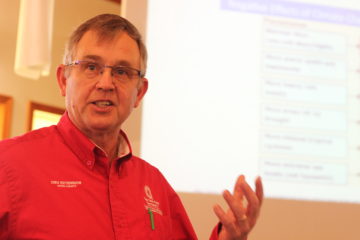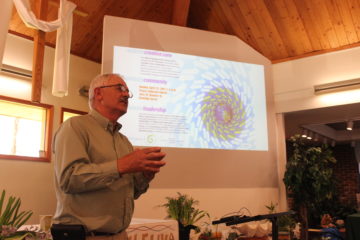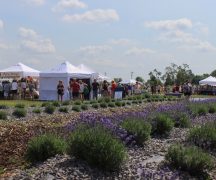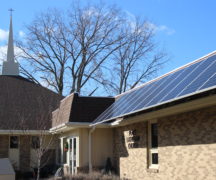By DAVID DUPONT
BG Independent News
Farmers are in the crosshairs of climate change.
The climate is moving south, said Neocles Leontis, one of the founders of the Black Swamp Green Team. That means as the years go by our weather will be more like what we associate with areas further south, and that means problems for agriculture.
The Black Swamp Green team is a loose-knit alliance of faith communities, advocacy groups, non-profits, and individuals that promotes energy efficiency, renewal energy, and sustainability.
As Pastor Deb Conklin, of Peace Lutheran said: “Who we are is whoever shows up when we make a decision.”
On Sunday the team hosted the Creation Celebration at Peace Lutheran. The event focused on agriculture, the challenges it faces, the ways of addressing those challenges, and its role in combating climate change.

Alan Sundermeier
Alan Sundermeier, of the Ohio State University Extension Service, catalogued the dangers. The effects of climate change can harm farms, whether it’s increasingly severe rainstorms or drought.
Drought, Sundermeier said, poses the greatest danger. High water rarely destroys an entire crop. Drought can.
But unpredictable weather, such as can late freeze, can also play havoc with crops. “The variability is more severe.”
That severe weather can also carry pests with them.
People have to keep in mind that: “Whatever we do, whatever small part we play, affects the rest of the world in big and small ways.”
The effects of rising temperature are many.
Leontis noted that 2016 was the warmest year on record.
Sundermeier showed a slide of a dry, brown field. That field should be green, he said. What could the farmer do to prevent such conditions?
“There are ways we can, maybe not totally mitigate, but maybe improve the productivity of our soils in Northwest Ohio when these sort of conditions happen,” he said. “They will happen, maybe floods, maybe drought. That’s what we’re faced with in agriculture, and we have to find ways to deal with it if we’re going to survive.”
The key is healthy soil. That’s not just good for farming, but for the atmosphere as well.
Soil is a “natural sink for carbon,” he said. “We want it in the soil, where it should be, not in the atmosphere.” Farmers think in terms of “organic matter,” he said. “That’s where the life is in the soil and where the active nutrients are.”
In the 1980s, agricultural experts started promoting no-till practices where the field were left as is after harvest, not plowed under. But there was missing a piece, Sundermeier said. Farmers came to realize this needed to be paired with the planting of cover crops that could help break up soil and regenerate it.
And best is a mix of cover crops, he said, that complement each other. More effort and money, he said, are being put into looking for “more practices that will improve soils improve, production, but not necessarily increase inputs like chemicals and fertilizers.”
One of the problems of modern agriculture was the advent of heavy machinery. As economics demand farms get bigger, large-scale equipment becomes necessary, Sundermeier said. It comes down to “production efficiency.”
But those heavy machines compact the soil. Some types of cover, such as oil-seed radishes, can help break the soil up, he said.

Paul Herringshaw
Other equipment is helping farmers grow crops more sustainably, local famer Paul Herringshaw said.
Using advanced GPS technology, he can apply fertilizer only along the rows where the corn is planted. The technology lets him plot where that row is and be accurate within an inch.
That allows him to use cover crops but leave those rows bare.
The technology for self-driving cars, he noted, was developed in agriculture, and the next step in farm equipment may be self-driving machinery that could be smaller but work around the clock.
Herringshaw said it was advances in technology that allowed farmers to employ no-till practices. At first, “we didn’t have the tools to plant into the heavy residue,” he said.
With cover crops, the farmer has to manage the balance between having the clover or cereal rye growing through the winter. But once the main crop – soybeans, wheat or corn – is in the ground, those once beneficial plants become weeds.
He has to be mindful that if he tries something and it fails, he won’t have crops to sell. “That’s what puts food on the table.”
“One thing I’ve been working with for many years is variable rate technology grid soil sampling,” he said. This allows him to sample smaller sections of ground using GPS, so he can apply the appropriate amounts of fertilizer. This is both a more efficient way to operate, but also helps to mitigate nitrogen run-off into Lake Erie.
“This is a learning curve,” he said. Non-farmers shouldn’t expect the agricultural community to change instantly.
Every piece of ground is different, he said. Wood County alone has 65 different soil types, each with its own qualities and characteristics.
“Every field is different,” Herringshaw said. “What works for me may not work for someone in Fulton County.”
From Herringshaw who operates 1,500-acre conventional operation, the program turned to Don Schooner who operates a 32-acre farm that raises everything from strawberries – from May to November – to crayfish, known as fresh water lobsters.
While his spread is on the other end of the agriculture spectrum from Herringshaw’s and those Sundermeier discussed, Schooner opened by praising what he’d just heard. “Those were probably the best reports I’ve heard. If that’s the way things are going to move, we’re looking at a better world.”
Schooner described his own operation as “tiny.”
He follows the practice of permaculture, cultivating not just annual crops, but those that persist from year to year.
He plants a variety of crops together, strawberry bed topped with garlic – nine varieties, and he hopes for as many as 30. That garlic helps keeps pests away.
These beds are not the flat neat rows, but raised mounds. This technique, hugelkulture, has been used for more than a 1,000 years, he said.
He also grows sweet potatoes in the mounds as well as blackberries, blueberries and raspberries.
Sometimes, Schooner said, farmers need to get away from the old ways and use the even older ways. But, he added, with new innovations.
That’s what Schooner Farms does. “We experiment with a lot of different things,” he said.
The farm has three ponds. The Schooners raise fish, those fresh water lobsters, and shrimp. Those shrimp now grow to eight inches long., Schooner envisions them at a foot long.
He uses bales of wheat straw to raise the shrimp. How? One of the problems with raising shrimp in a pond is that to harvest them, the pond has to be drained. So he used hay bales around the pond to build a covered trough. Then to harvest, he just has to empty that.
He grows oyster mushrooms on the bales, as well. Using a floating raft system, he uses aquaponics to grow lettuce on the surface of the ponds. The plants are fertilized by the fish waste. That in turn cleans the water.
Hay bales are a key ingredient in his formula. The strawberry beds are made from them. In the first two weeks he may have to add some natural nutrients, but the bales decay and feed the strawberries. Those mounds also hold heat.
“I was actually really surprised how much production we had out of a simple straw bale.”
The mounds are constructed to recreate the forest floor. Limbs, twigs, and leaves are buried under topsoil. He then digs swales between the mounds. When heavy rains descend, the water runs into the swales, and irrigates the mounds even when the rain stops and doesn’t return for weeks.
Those mounds, Schooner said, will last for 10-12 years. When they are exhausted, he’ll reverse the position of the swale and mounds and be set for another decade.
Schooner’s mission is not just to raise crops for market, but to raise public awareness. Schooner says the farm wants “to set an example for people who live in town or out in the country to show them ways these things could be done.”
Later, he added: “You can do it on your own yard and raise some of your own food.”
The next big project is to turn seven acres into a “food forest.” That will involve about 1,000 feet of swale and berm. In that area, he will plant hundreds of types of fruit trees, bushes and herbs.
“Our entire farm is set up to try some of these unique weird ways of doing things, things that have been done for a thousand years but we tweak them,” he said. “That’s what we’re after.”
Schooner said he was inspired by the work of Wisconsin naturalist Aldo Leopold and his seminal book on the environment “Sand County Almanac.”
Land is a limited resource, Schooner said. More is not being made, “so we have to take care of it.”





